

 Vol. 39 (Number 52) Year 2018. Page 9
Vol. 39 (Number 52) Year 2018. Page 9
Olga V. LOSEVA 1; Irina U. BELYAEVA 2; Marina A. FEDOTOVA 3; Marina M. PUKHOVA 4; Anna A. BAKULINA 5
Received: 27/06/2018 • Approved: 15/09/2018 • Published 28/12/2018
ABSTRACT: The relevance of the research is caused by the need to improve the quality of the property management of higher education institutions in terms of the innovative infrastructure development of universities using the model of the “university educational campus”, by the insufficient development of theoretical and methodological foundations for the formation of property management models of universities and performance indices in various areas. The goal of the study is to develop property management models of universities and performance indices to assess the performance of these premises used by the university. Research methods: the leading approaches to the study of the problem are functional and process approaches that allow considering the property management as a purposeful process to improve the quality of its performance in the interests of all participants in the educational process. Results of the research: the study presents the main campus management models- functional, process, program, project, as well as models, principles and performance indices to assess the use of university premises. Recommendations are proposed for assessing the quality management system of university campuses. Practical significance: the obtained results are aimed at the theoretical and methodological support to increase the performance of the property management of the higher education institution used by the institution and by the state. |
RESUMEN: La relevancia de la investigación se debe a la necesidad de mejorar la calidad de la gestión de la propiedad de las instituciones de educación superior en términos del desarrollo innovador de infraestructura de las universidades utilizando el modelo del "campus universitario de educación", por el insuficiente desarrollo de conocimientos teóricos y metodológicos. Fundamentos para la formación de modelos de gestión de propiedades de universidades e índices de desempeño en diversas áreas. El objetivo del estudio es desarrollar modelos de gestión de propiedades de las universidades e índices de rendimiento para evaluar el rendimiento de estas instalaciones utilizadas por la universidad. Métodos de investigación: los enfoques principales para el estudio del problema son enfoques funcionales y de proceso que permiten considerar la administración de la propiedad como un proceso intencional para mejorar la calidad de su desempeño en interés de todos los participantes en el proceso educativo. Resultados de la investigación: el estudio presenta los principales modelos de gestión del campus: funcional, proceso, programa, proyecto, así como modelos, principios e índices de rendimiento para evaluar el uso de las instalaciones universitarias. Se proponen recomendaciones para evaluar el sistema de gestión de la calidad de los campus universitarios. Importancia práctica: los resultados obtenidos se dirigen al apoyo teórico y metodológico para aumentar el rendimiento de la gestión de la propiedad de la institución de educación superior utilizada por la institución y por el estado. |
The evaluation results of the property management experience of higher education institutions make it possible to state that one of the most promising areas for reforming the educational environment is the creation of university campuses of various types. Consequently, research and scientific development are needed to solve the problems of their functioning and effective use, including improving the quality of the property management system. The authors conducted a number of studies on the problems of improving the property management of universities, in particular:
1) The best world practices in the campus property management were studied using the example of the USA, Great Britain, France, Germany, Finland, Switzerland, Israel, China, Malaysia, Russia (Fedotova & Loseva, 2017; Belyaeva & Pukhova, 2016);
3) On the basis of the conducted research:
- Campus property management models of higher education institutions are developed;
- Models, principles and performance indices to assess the performance of these premises used by the university are developed;
- Recommendations to assess the quality of the campus management system are given.
The university property management system should include such elements as the definition of management goals, tools for achieving goals, the regulation of the procedure for making managerial decisions, control over management objects, reporting, management decisions based on the analysis of monitoring and reporting results, responsibility for management results, entry, processing and analysis of information about managers and management of infrastructure facilities. The proposed model is presented in Figure 1.
Fig. 1
Elements of the university property management system
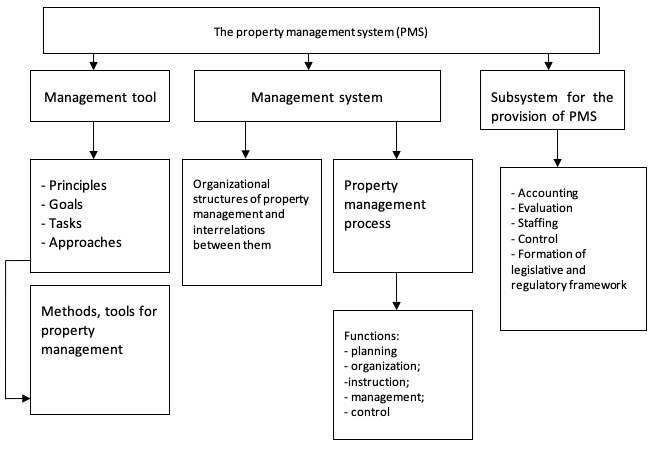
Source: compiled by the authors.
This university property management system is generalized and can be specified by each institution using a particular management model.
The basis for the performance evaluation of the campus property management is based on various concepts that are used in one way or another abroad. The basic ones include:
1) The concept of optimal performance, energy efficiency and energy saving in the operation of areas (Ding & Zhang, 2018; Guan, Nord & Chen, 2016; Kolokotsa, Yang, Eang, 2018; Popoola et al., 2018);
2) The concept of management, focused on value added (Gao & Sang, 2017);
3) The concept of the greatest satisfaction of social needs of society in obtaining qualitative educational services in the digital economy (Nalmpantis et al., 2017; Tan, Chen, Shi & Wang, 2014; Williams & Smith, 2016; Saadatian, Sopian & Salleh, 2013).
The first concept defines technical and ergonomic requirements for the performance of the property management, including the use of space, the second and the third are value-oriented goals of their use. Based on these concepts, the authors formulated models for the performance evaluation of the university property management, including its areas: functional, economic and social.
The concept of value added is the basis for implementing an effective tool for applying strategic and operational solutions for the property management as a business.
The analysis of the educational practice allowed making the conclusion that in addition to technological and ergonomic performance indices used by many universities, it is necessary to introduce cost indices in the system of performance indices when higher education institutions use their areas.
New investments should be made only upon the condition that they create a new value. At the same time, new investments are created only when the profitability of these investments is higher than the cost of attracting capital.
The modern higher education institution is in constant competition with other organizations for funding sources and, if the institution cannot provide an acceptable growth for the value of the investor, it is deprived of this resource.
The value added concept provides campus managers with tools which can increase the value of the property complex by influencing cost factors.
In the course of this research, the following methods were used: theoretical (analysis, synthesis, concretization, generalization, method of analogies, modeling); empirical (study of the experience of higher education institutions, normative and legal documentation and observation); methods of theory and practice of the complex management system, quality management; methods of tabular representation and graphical visualization of results.
The information basis of the research is analytical materials in the field of campus performance of the world’s leading universities, including in the sphere of the property management and efficiency of using university areas; regulatory and legal framework controlling the activities of higher education institutions in various countries of the world; periodicals on the subjects under study; statistical data; Internet resources, etc.
The study of the problem was carried out in three stages:
1) At the first stage, the authors carried out a theoretical analysis of existing methodological approaches to the formation of university property management models and evaluated the performance of these premises used by the university;
2) At the second stage, the authors developed property management models of higher education institutions, including models for the university performance evaluation using its premises as an integral part of the property complex; principles and indices for the performance evaluation of these premises used by the university.
3) At the third stage, the authors presented recommendations to improve the quality of the property management system, summarized and systematized the results obtained.
1. A functional management model assumes delegation of powers and responsibility on the property management in conformity with performed functions, united through directions of activity. Function - a subsystem of processes in the organization, which is defined through the similarity of these processes (performed by employees).
The developed functional property management model of the campus is presented in Figure 2.
Fig. 2
Functional property management model
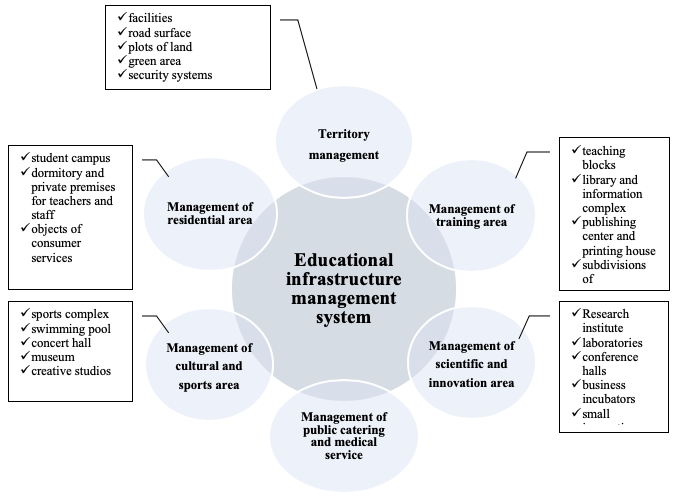
Source: compiled by the authors
Formation of functional areas allows taking into account the features of infrastructure facilities.
2. For a more detailed approach to the formation of the property management system, it is need to develop a management process model. The process management model assumes such delegation of authority and responsibility, which is based on a certain “business process”. The business process is a stable, repetitive activity that converts resources into results. The main problem with the use of the process management model is the definition of process boundaries and elements of authority and responsibility associated with them.
The management of each process can be represented as a function that depends on four parameters:
У=f (E, G, I, C), (1)
where E – executor; G – goal management; I – implementation; C – control (goal achievement indices).
As an example, the authors considered the developed management model for a specific process “Ensuring the performance of campus infrastructure facilities” (Figure 3).
Fig. 3
Management process model “Ensuring the performance of campus infrastructure facilities”
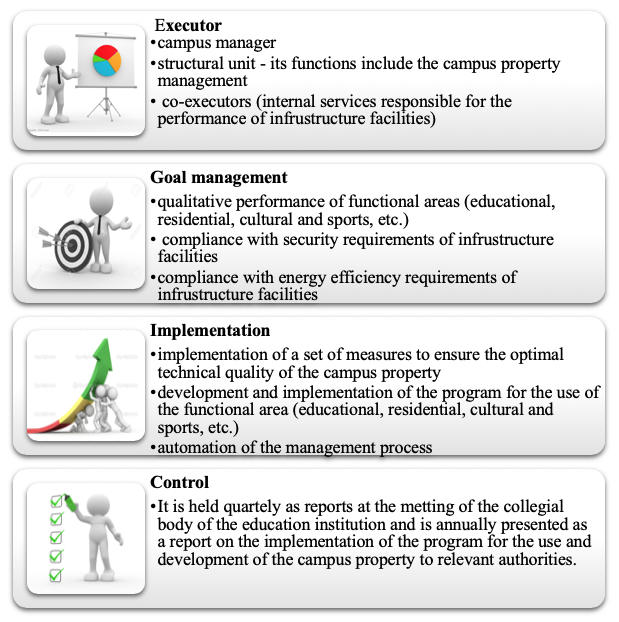
Source: compiled by the authors
Practical implementation of this model in state universities is carried out on the basis of orders and methodological recommendations developed by public authorities, as well as local acts of the university (programs, regulations, standards). Similar models can be built for any process.
3. The project management model assumes the delegation of authority and responsibility through the creation and implementation of individual projects. The project is considered as a one-time (not repetitive) activity, for the implementation of which a project team is created on a functional basis. The authority and responsibility related to the effectiveness and efficiency of the project are delegated to the project manager. An example of the project approach to the campus property management may be a project to modernize it, implemented by using public-private partnership tools.
Creation and modernization of campuses will allow universities:
- Organize long-term scientific research, attracting resources of business structures;
- Stimulate innovation;
- Create an innovative infrastructure that can integrate scientific developments into the real sector of the economy;
- Establish technology transfer centers;
- Build comfortable hostels, etc.
4. The program management model assumes, first of all, the formation of the campus property development program. Figure 4 illustrates an example of such program.
Fig. 4
Formation of the campus property development program
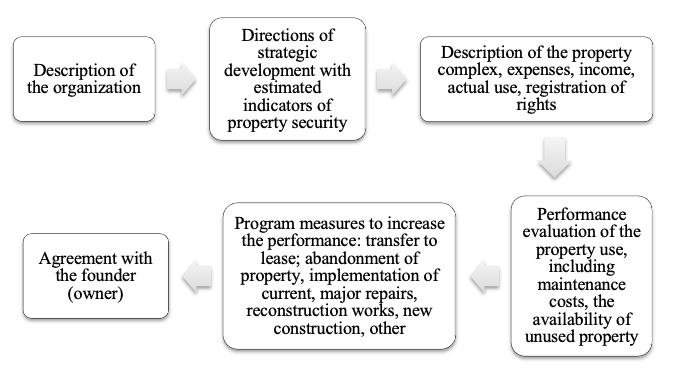
Source: compiled by the authors.
As the analysis of the world experience shows, in practice universities can use one or more of the considered management models in interrelation (Byggningsstyrelsen, 2013; Eriksson et al., 2015; Yoshida, Shimoda, Ohashi, 2017; Groenwald, 2017). This will ensure the systematic nature of management.
On the basis of the models reviewed, each education institution can form its own property management system that takes into account the type of the campus and the features of the institution.
The property performance evaluation is an integral part of the campus property management system, therefore it should rely on the following groups of approaches for making managerial decisions with regard to the infrastructure facilities of evaluation.
The first group of approaches is aimed at the substantive side and characterizes the requirements for the property performance evaluation:
1) The approach of the relevant evaluation to the current and strategic goals of evaluated subjects suggests that the motivational, controlling, managing, developing, economic and other evaluation functions are not formed arbitrarily, but in accordance with the urgent needs and goals of the university and property owner;
2) The approach of scientific validity means the creation of a scientific and methodological base for carrying out evaluation procedures for all types of HEIs;
3) The approach of formalizability and standardization involves the development of a system of evaluation indices based on proposed models, as well as the interpretation of evaluation results based on quantitative and qualitative norms and criteria, etc.
The second group - approaches characterizing the requirements for performance evaluation procedures for the property use:
1) The approach of adaptability implies the possibility of adjusting the selection criteria and evaluation indices depending on the change in goals, needs and conditions of vital activity of the subjects of evaluation;
2) The approach of continuity implies the regularity and systematic nature of evaluation procedures, the continuous improvement of technology and methods for the property performance evaluation, taking into account the results obtained, as well as trends and patterns of the university and the education system development;
3) The approach of concentration implies the concentration of functions for the property performance evaluation in the framework of a specialized campus center (unit) established on a permanent basis for managing the university property complex, etc.
In its most general form, performance is defined as the possibility of achieving a positive result. In relation to the research conducted, the result should be the use of premises by the higher education institution, which ensures high quality of the educational process and at the same time the maximum benefit from areas that are not involved in the training activity, with the minimum allowable costs to ensure their performance.
To achieve this result, three approaches to performance evaluation are proposed:
1) Functional - shows how it is possible the use of premises involved in training activities and not involved in training activities (level of technical condition, compliance with sanitary standards, energy efficiency requirements, etc.), characterizes the condition of premises and the quality of their performance;
2) Economic - shows how efficiently the resources used are to operate the areas, the profitability from disposing of the property, and characterizes the validity of costs when maintaining and modernizing areas, the profitability of their use;
3) Social - shows how fully the premises that are not involved in training activities are used, how feasible it is to achieve the development goals of the university property complex in accordance with its strategy, characterizes the satisfaction of consumers and the owner using the areas provided to the university.
Each of these approaches can be implemented through the application of a particular performance evaluation model (Figure 5).
The performance evaluation model of the property involved in training activities and not involved in training activities is a complex, the components of which are goals, the external environment, management tools, technologies and methodologies for the performance evaluation.
In accordance with these approaches, the following performance evaluation models can be singled out:
1) The performance evaluation model (realizes the functional approach) is based on the assessment of the ability of premises to perform optimally the given functions in a certain range of changing conditions; efficiency and timeliness of identifying and solving problems of safe operation;
2) The economic performance evaluation model (realizes the economic approach) is based on the evaluation of profitability from the use of areas not involved in training activities; expediency and sufficiency of funds spending to ensure their proper performance;
3) The social performance evaluation model (realizes the social approach) is based on a comparative assessment of the given and realized goals of using the areas, the results obtained with the objective needs of the university and property owner.
Fig. 5
The relationship of performance evaluation approaches and models of the campus areas.
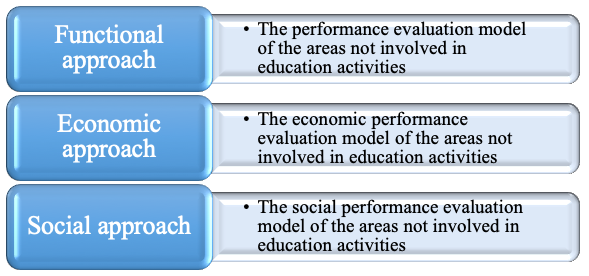
Source: compiled by the authors
These performance evaluation models (like the three distinct approaches) are in close unity and interconnection. Without effective financing, there cannot be the productive performance of the areas, which, in turn, is necessary to achieve development goals of the university and the satisfaction of consumers and the property owner using the areas provided by the university.
The introduction of performance evaluation models and approaches involves the use of appropriate evaluation tools, among which the most developed are various systems of balanced indices.
The performance evaluation based on balanced indices is a powerful analysis tool in the process of implementing strategic goals of any organization.
The basis for the formation of a balanced system of indices is the choice of performance criteria.
The approaches chosen by the authors allow formulating the basic criteria:
1) The criterion of the functional performance;
2) The criterion of the economic performance;
3) The criterion of the social performance.
Each of these criteria can be expressed by a set of actual indices corresponding to a particular performance model.
Based on the criteria considered, we will form a system of indices for the performance evaluation of the areas.
The performance index is a characteristic that allows quantifying the performance criterion. It allows relating:
1) The actual value with the desired or required one (regulatory-target indices);
2) Values in different time periods (dynamics indices);
3) Values related to different HEIs (indices of comparison or ratings).
The system of performance indices is a set of indices grouped according to three performance models:
1) A group of indices for the performance evaluation of the areas not involved in training activities;
2) A group of indices for the economic performance evaluation of the areas not involved in training activities;
3) A group of indices for the social performance evaluation of the areas not involved in training activities.
Thus, the system of balanced indices for the performance evaluation of the areas can be presented in the form of the following table (Table 1).
Table 1
System of balanced indices for the performance evaluation of the areas
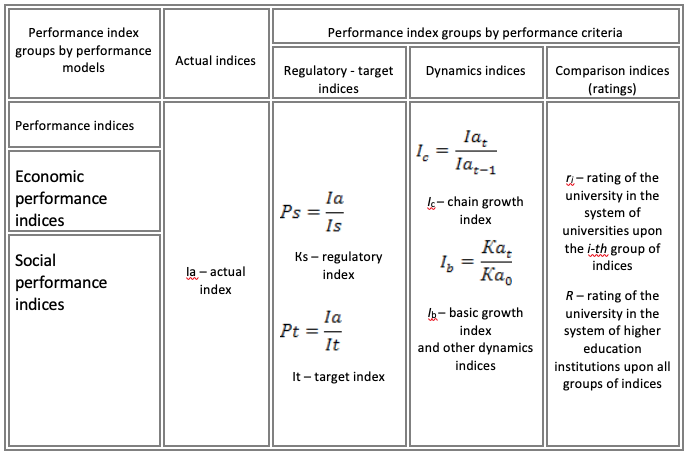
Source: compiled by the authors.
From Table 1 it follows that regulatory and target indices, dynamics and comparison indices are formed on the basis of actual indices corresponding to performance models.
Based on the selected selection criteria, we will form groups of actual indices for the performance evaluation of the areas in accordance with performance models (Table 2).
Table 2
Actual performance evaluation indices of the areas involved in training activities
No |
Index name, unit of measure |
Notation |
Explanation of the calculation |
|
Group of performance indices |
||||
1 |
Share of the areas meeting technical safety requirements,% |
dts |
In the numerator - the area of premises, the percentage of technical deterioration for which does not exceed 60%, minus the area of premises that are under repair, emergency condition or reconstruction, m2. |
|
2 |
Share of the areas meeting fire safety requirements,% |
dfs |
In the numerator - the area of premises that meet fire safety requirements, including fire alarm equipment, m2. |
|
3 |
Share of the areas meeting counter-terrorist security requirements,% |
dcts |
In the numerator - the area of premises that meet counter-terrorist security requirements, m2. |
|
4 |
Share of the areas meeting sanitary standards and requirements,% |
dss |
In the numerator - the area of premises that meet sanitary standards and requirements, m2. |
|
5 |
Share of the areas meeting energy efficiency requirements,% |
dee |
In the numerator - the area of premises equipped with appropriate meters, m2. |
|
6 |
Share of training and laboratory facilities equipped with modern teaching, scientific and research-and-production equipment |
deq |
In the numerator - the area of educational and laboratory facilities, equipped with modern teaching, scientific and scientific-production equipment, m2. |
|
Group of economic performance indices |
||||
1 |
Mobilization index of extra-budgetary funds per unit area, rubles / m2 |
Imf |
The numerator - the amount of attracted extra-budgetary funds, rubles. |
|
2 |
Profitability index of the areas used |
Ipu |
The numerator - the amount of funds received from the area used, thousand rubles. |
|
3 |
Profitability index of the areas leased (profitability of rent) |
Ipl |
The numerator - the amount of funds received from the lease of premises, thousand rubles. |
|
4 |
Capital productivity index of the areas put into service |
Icp |
The numerator - the amount of current funds received from the areas put into service (new, repaired, reconstructed, modernized), thousand rubles. |
|
5 |
Expenditure index per unit area |
Iex |
The numerator - the amount of mandatory payments related to the property and its content, and the cost of utilities and maintenance services (by types of areas), thousand rubles. |
|
Group of social performance indices |
||||
1 |
Performance index of the area |
Ip |
The numerator - the time during which the area is involved in training activities (by types of areas), h / year. |
|
2 |
Legal validity index of using the areas |
Ilv |
The numerator - the area used for reasonable internal reasons and for legitimate external grounds, m2. |
|
3 |
Index of the development program implementation |
Ipi |
The numerator - the number of achieved development program goal indices of the university property complex, related to the use of the areas. |
|
4 |
Conformity index with modern social requirements of trainees and staff |
Icr |
The arithmetic average of the following indices: |
|
Source: compiled by the authors.
The presented actual fifteen indices are supplemented by regulatory-target indices (if necessary), dynamics and comparison indices in accordance with Table 1.
To assess the university property management system, it is necessary to diagnose this system in the following areas:
1. Analysis of goal-setting and management structure, which includes:
- Analysis of strategic goals and objectives of the university development, the availability of the property development program, the availability of measurable indices for their subsequent monitoring, the availability of the system for forecasting the needs of property and its quality;
- Analysis of the organizational structure of the university property management - formalization of the management structure, the number of levels in the hierarchical management structure, the availability of formalized functions at each level, the degree of centralization and concentration of powers, the analysis of quantitative characteristics, such as the share of administrative and management personnel (AMP) in the total number of AMP;
- Analysis of the information system for the university infrastructure management, the organization of information flows, the electronic document management system, etc.
2. Interaction with the main agents of the education system and the degree of resource dependence of the university, including:
- Analysis of the possibility to use commercial revenues for solving the problems of the property development, the share of property financing from such sources in the total share of financing;
- Analysis of interaction between the university and other universities, ministries, local authorities, employers and other stakeholders in the development and adoption of decisions in the property management.
3. Organization and motivation of campus managers:
- Availability of job descriptions and regulations;
- Availability of the incentive payment system, the share of bonuses in the total amount of payments, availability of effective contracts, etc.
4. Availability of the resource management system, the quality of available resources and their performance:
- Evaluation of available resources (implementation of regulatory values);
- Qualitative evaluation of resources (energy efficiency, environmental friendliness, etc.);
- Performance indices of resource use.
5. Satisfaction with the fundamental approaches of the property management (table 3).
Table 3
Basic approaches in the formation of the property management
system of HEIs and the criteria for their compliance
Approach |
Criteria for compliance with the approach requirements |
Goal-setting |
Use of the property complex is defined; Specific tasks are identified |
Planning |
Plans for the creation, modernization, repair, financing of the property complex, etc. are developed. |
Monitoring |
Availability of indices for measuring the timing and forms of reporting, the system for assessing the results and performance |
Established minimum regulatory compliance |
Availability of the system of established norms, mechanisms for verifying compliance with these norms |
Safety |
Include and verify the availability of technological, technical safety criteria when implementing property development plans |
Technological performance |
Taking into account the specificities of higher education institutions, develop criteria for achieving the required level of property complexes in terms of the scientific-technological progress |
Comfort |
Approach that combines objective parameters and subjective perceptions and expectations |
Cost performance |
In terms of sustainable development of society, the approach of profitability is of particular importance. It covers all spheres of the university infrastructure management |
Standardization |
Availability of standardization programs for management processes |
Availability of a unified idea that unites space |
Availability of a single design solution that characterizes the specifics of the territory and training space of the campus |
Adaptability |
Ability of the university property management system to change in connection with the requirements and challenges of the external environment |
Efficiency |
Reducing the timing of interaction between the units of the system, including the owner-user interaction |
Source: compiled by the authors
As a model for building the university property management system, a functional, process, project model has been proposed. At the same time, in order to improve the management performance, it is advisable to apply a combination of indicated models and take into account requirements of a systematic approach to management. For the strategic development of the campus property, a corresponding set of measures has been developed in the form of a program management model that should correlate with the university development program as a whole.
The presented models of university property management systems and proposed recommendations on accessing their quality can be used in the activities of government bodies, higher education institutions and in the teaching process while teaching relevant administrative disciplines.
One of the most important components of property management systems is the effective use of the areas involved in training activities by the university, which ensures a high quality of the educational process and at the same time the maximum benefit from areas that are not involved in training activities, with the minimum allowable costs to ensure their performance. To achieve this result, it is suggested to distinguish three interrelated models for the university performance evaluation when using these premises:
1) The performance evaluation model is based on the assessment of the ability of premises to perform the given functions in a certain range of changing conditions; characterizes the level of technical condition, compliance with sanitary standards, safety requirements, energy efficiency, energy saving, etc. (the concept of effective operation);
2) The economic performance evaluation model is based on the assessment of profitability from the areas not involved in training activities, the feasible expenditure adequacy to ensure the proper performance; characterizes the validity of costs for the maintenance and modernization of areas, the profitability of their use (the concept of value added);
3) The social performance evaluation model is based on the comparative assessment of the given and ongoing goals when using the areas, the correspondence of the results with the objective needs of the university (the property development program), the region and the property owner; characterizes the usefulness of the property, the degree of satisfaction of consumers and the owner using the property provided by the university (the concept of the greatest satisfaction of social needs of society in obtaining high-quality educational services).
The study represents a system of balanced indices for the performance evaluation of the areas in accordance with the proposed performance models.
The introduction of performance evaluation procedures can significantly improve the quality of the university property management and, accordingly, the quality of implementation of basic and additional educational programs of the university.
Belyaeva, I.Yu., & Pukhova, M.M. (2017). Osobennosti upravleniya imushchestvennym kompleksom rossiiskikh vuzov v ramkakh sozdaniya sistemy kampusov. Sovremennye korporativnye strategii i tekhnologii v Rossii sbornik nauchnykh statei. Moskva: Finansovyi universitet, pp. 6-17.
Byggningsstyrelsen (2013). Campus Development, Method and Process. Denmark. Retrieved from: www.bygst.dk/om-os/publikationer/campusudvikling-metode-og-proces.
Ding, Y. & Zhang, Z. (2018). Benchmark analysis of electricity consumption for complex campus buildings in China. Applied Thermal Engineering, Vol. 131, pp. 428-436.
Eriksson, R. & Nenonen, S., Junghans, A., Balslev, S., Nielsen, G. Lindahl (2015). Nordic Campus Retrofitting Concepts – Scalable Practices. Procedia Economics and Finance, Vol. 21, pp. 329-336.
Fedotova M.A., & Loseva O.V. (2017). Razvitie sistemy upravleniya imushchestvennym kompleksom universitetskikh kampusov: luchshie rossiiskie i zarubezhnye praktiki. Moskva: RUSAINS. 104 p .
Gao, J. & Sang, Y. (2017). Identification and estimation of landslide-debris flow disaster risk in primary and middle school campuses in a mountainous area of Southwest China. International Journal of Disaster Risk Reduction, Vol. 25, pp. 60-71.
Groenwald, S.L. (2017). The challenges and opportunities in leading a multi-campus university. Journal of Professional Nursing.
Guan, J., Nord, N., & Chen Sh. (2016). Energy planning of university campus building complex: Energy usage and coincidental analysis of individual buildings with a case study. Energy and Buildings, Vol. 124, pp. 99-111.
Kolokotsa, D., Yang, J., & Eang, L.S. (2018). 5.20 Energy Management in University Campuses. Comprehensive Energy Systems, Vol. 5, pp. 808-826.
Nalmpantis, D. et al. (2017). The concept of woonerf zone applied in university campuses: the case of the campus of the Aristotle University of Thessaloniki Transportation Research. Procedia, 24, pp. 450–458.
Popoola, S.I. et al. Smart campus: Data on energy consumption in an ICT-driven university. Data in Brief 16 (2018), pp. 780–793.
Saadatian, O., Sopian, K.B., & Salleh, E. (2013). Adaptation of sustainability community indicators for Malaysian campuses as small cities. Sustainable Cities and Society, Vol. 6, pp. 40-50.
Tan, H., Chen, Sh., Shi, Q., Wang, L. (2014). Development of green campus in China. Journal of Cleaner Production, Vol. 64, pp. 646-653.
Williams, R.D. & Smith, C. A. (2016). Constructing the information ground of the campus disability center. Library & Information Science Research, Vol. 38, Issue 4, pp. 285-291.
Yoshida, Y., Shimoda, Y., & Ohashi, T. (2017). Strategies for a sustainable campus in Osaka University. Energy and Buildings, Vol. 147, pp. 1-8.
1. Department of Corporate Finance and Corporate Governance Federal State-Funded Educational Financial University under the Government of the Russian Federation, Moscow, Russia, E-mail: OVLoseva@fa.ru
2. Department of Corporate Finance and Corporate Governance Federal State-Funded Educational Financial University under the Government of the Russian Federation, Moscow, Russia, E
3. Department of Corporate Finance and Corporate Governance Federal State-Funded Educational Financial University under the Government of the Russian Federation, Moscow, Russia, E-mail: mfedotova@fa.ru
4. Head Postgraduate Education Office Federal State-Funded Educational Financial University under the Government of the Russian Federation, Moscow, Russia, E-mail: mpuhova@fa.ru
5. Federal State-Funded Educational Financial University under the Government of the Russian Federation, Moscow, Russia, E-mail: abakulina@fa.ru